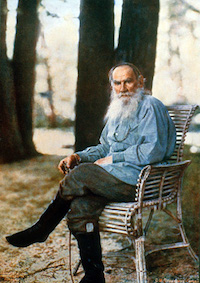The writing style of
Leo Tolstoy
Leo Tolstoy
1828-1910
Russian writer regarded as one of the greatest authors of all time, known for 'War and Peace' and 'Anna Karenina'.
Leo Tolstoy, one of the titans of literary history, is renowned not only for the epic scope of his novels but also for his distinctive writing style, which has captivated readers and scholars alike. His narrative approach combines a keen observation of detail with a profound moral and philosophical depth, presented through a style that is both accessible and artistically sophisticated.
Tolstoy’s prose is marked by its clarity and straightforwardness. Unlike many of his contemporaries, he eschewed overly ornate language, opting instead for simplicity and precision. This directness, however, does not detract from the complexity of his thoughts or the subtlety of his analyses. It serves to enhance the immediacy and intimacy of his narrative voice, drawing readers into the lives of his characters and the intricacies of their psychological landscapes.
One of the hallmarks of Tolstoy’s style is his use of detail. He had an extraordinary ability to notice and describe minute aspects of everyday life, lending a sense of authenticity and vibrancy to his scenes. These details are never superfluous; each serves to build the world of his novels, enriching the reader’s understanding of the characters and their environments. This meticulousness extends to his portrayal of characters, whom he crafts with such psychological depth and nuance that they seem to transcend the pages of his books to become real human beings with complex inner lives.
Tolstoy’s sentence structure often reflects the internal state of his characters. In moments of turmoil or intensity, his sentences may become longer, mirroring the complexity of thoughts and emotions. Conversely, in moments of clarity or epiphany, his sentences are notably shorter, delivering the essence of the revelation with striking force.
In exploring themes of morality, spirituality, and the human condition, Tolstoy frequently employs dialogue and inner monologue, techniques that allow him to dissect his characters’ moral dilemmas and philosophical reflections without imposing a didactic voice. This use of characters as vessels for ideas enables him to weave rich tapestries of thought and emotion, making his novels not only engaging narratives but also profound philosophical inquiries.
